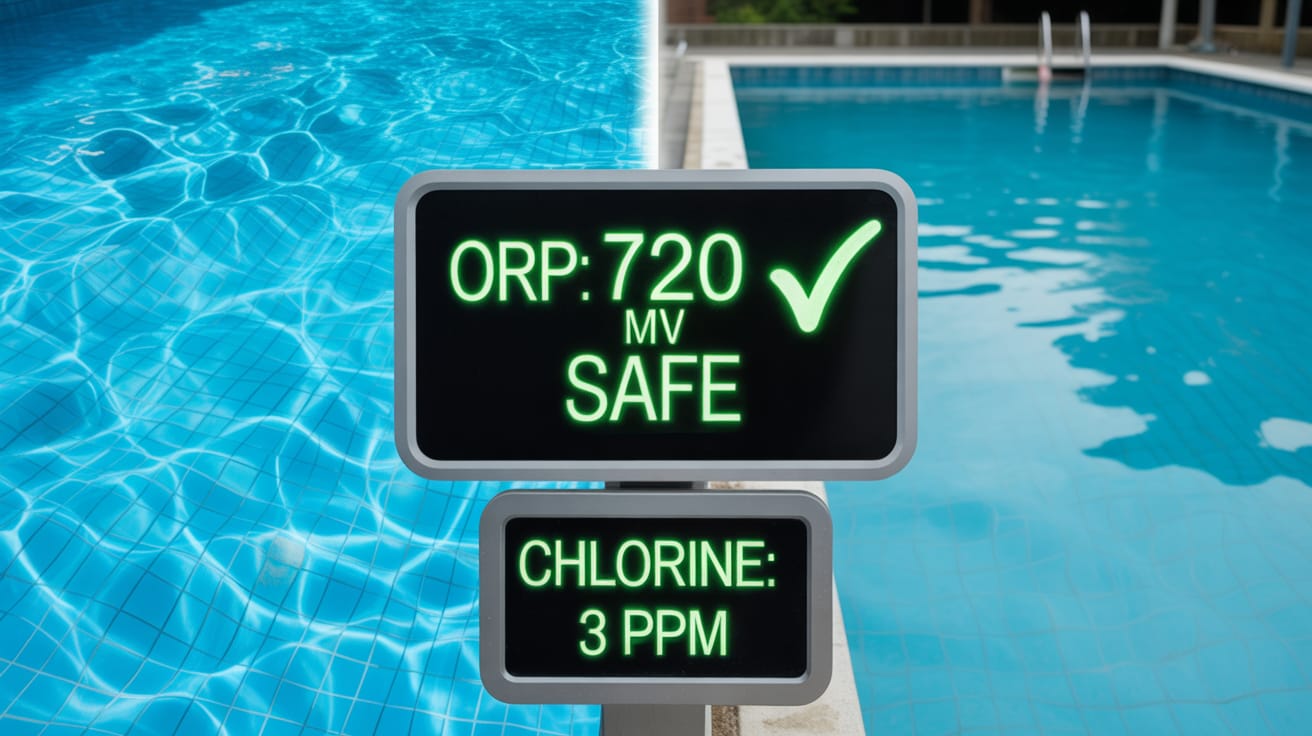What Is the ORP in the Pool? Your Essential Guide to Water Sanitising Power

If you own a swimming pool, you know that clear water doesn't always mean clean water. While testing for Free Chlorine gives you the amount of sanitiser present, it fails to tell you how effective that sanitiser is.
This is where ORP (Oxidation-Reduction Potential) comes in. Understanding the ORP pool's meaning is the single most reliable way to gauge your water's true sanitising strength and safety. It acts as the ultimate "health score" for your pool water, indicating its ability to instantly kill bacteria and contaminants.
In this comprehensive guide, we'll explain exactly what ORP means, the international standards you should follow, why it's a superior measurement to chlorine levels alone, and how to maintain perfect ORP for a truly safe and sparkling swimming environment.
What is ORP (Oxidation-Reduction Potential)?
ORP, or Oxidation-Reduction Potential, is a measurement of a pool's water quality based on its ability to break down contaminants.
The simplest ORP pool meaning is this: it measures the water’s cleaning power.
- Oxidisers (like chlorine) are agents that "steal" electrons from contaminants (like bacteria, algae, and organic waste), effectively neutralising or destroying them.
- Reducers (the contaminants themselves) donate electrons.
The ORP reading measures the concentration of these oxidisers relative to reducers in millivolts (mV).
In practical terms, A higher ORP value means the oxidising agent (your sanitiser) is more active, more efficient, and has a greater capacity to destroy pathogens immediately. A low ORP reading means your sanitiser is sluggish and your pool is unsafe, regardless of how much chlorine you've added.
The Science Behind the Reading: A Simplified Look at the Nernst Equation
ORP is not measured by counting molecules; it is measured electrochemically. An ORP meter uses an inert electrode (typically platinum) and a reference electrode (like silver/silver chloride) submerged in the pool water.
The voltage difference (measured in mV) between these two electrodes is the ORP reading. This voltage is governed by a fundamental principle of electrochemistry known as the Nernst Equation.
In the context of pool water, the Nernst Equation shows that the measured ORP value is directly linked to the ratio of the effective concentration of your oxidiser (e.g., Hypochlorous Acid, HOCl) to the concentration of organic contaminants (reducers). More importantly, the equation shows a crucial dependence on the water's pH.
The Key Takeaway for Pool Owners: This scientific relationship proves why ORP is the most accurate real-time indicator of sanitising strength. Any factor that reduces the effective concentration of the oxidiser (most notably a high pH) will cause a drop in the measured ORP value, proving the sanitiser is less potent.
The Ideal ORP Standard for Safe Swimming Pools
The question "what is a good ORP level?" has a clear answer backed by global health organisations and industry associations.
According to guidelines from the World Health Organization (WHO), the minimum practical level for safe disinfection is 650 mV.
| ORP Range (mV) | Safety & Action Required |
|---|---|
| Below 650 mV | Danger Zone. Sanitiser effectiveness is dangerously low. Immediate corrective action needed (check pH, then adjust chlorine). |
| 650 mV – 700 mV | Acceptable Minimum. Provides effective disinfection but leaves little margin for safety. Should be managed closely. |
| 700 mV – 750 mV | Ideal Range. Ensures rapid and effective destruction of nearly all pathogens. This is the optimal target range for commercial and residential pools. |
| Above 750 mV | High. Water is extremely safe, but prolonged very high levels may indicate excessive sanitiser use, potentially leading to faster equipment corrosion or skin irritation. |
The consensus best practice is to aim for 700 mV or higher to ensure your pool's water is consistently and reliably safe for swimmers.
Why ORP is More Reliable than Free Chlorine Level
Many pool owners rely solely on testing for Free Chlorine (FC), but this only tells half the story. Free Chlorine measures the quantity of chlorine in parts per million (ppm), not its quality or killing efficiency.
ORP is a superior measurement because it provides a direct reading of the sanitiser’s efficiency, factoring in the water’s chemistry.
| Feature | ORP (Oxidation-Reduction Potential) | Free Chlorine (FC) |
|---|---|---|
| What it Measures | The Activity, Power, or Efficiency of the sanitiser (mV). | The Quantity or Concentration of the sanitiser (ppm). |
| Indicator of Safety | Direct and immediate indicator of pathogen-killing ability. | Indirectly, as its power is heavily affected by pH. |
| Main Drawback | Heavily influenced by pH level. | Does not account for pH influence on effectiveness. |
The Critical Interplay (Example):
A common scenario is having High Free Chlorine (e.g., five ppm) but Low ORP (e.g., 500 mV). This usually happens when the pH is too high (above 7.8). High pH essentially puts the chlorine to sleep, meaning you have a lot of chlorine, but it's too weak to effectively kill germs. The low ORP reading immediately flags this danger, while the FC test would misleadingly suggest the water is safe.
How to Maintain Optimal ORP Levels in Your Pool
Maintaining a consistent ORP reading within the 700-750 mV range requires balancing the core factors of pool chemistry.
Step 1: Balance the pH Level (The Most Critical Factor)
As noted, pH is the primary factor influencing ORP. Chlorine is most effective—and ORP is highest—when the pH is within the 7.4 to 7.6 range.
- If ORP is low: Test your pH immediately. If it's too high (above 7.8), use a pH decreaser (muriatic acid or sodium bisulphate) to bring it down.
- If pH is too low (below 7.2), the ORP might be high, but the water will be corrosive. Use a pH increaser (soda ash).
Step 2: Optimise Sanitiser (Chlorine) Levels
Once your pH is stable, ensure your Free Chlorine (FC) is in the recommended range of 1-3 ppm. The right amount of chlorine, combined with the ideal pH, will naturally drive your ORP reading up into the safe zone.
Step 3: Remove Organic Contaminants
Organic contaminants (leaves, dirt, skin oils, sunscreen) consume your sanitiser, rapidly lowering the ORP. The more clean-up your pool requires, the more the oxidisers are "wasted" on dirt instead of germs.
Sustaining High ORP: The Advantage of Smart Tools and Automation
Maintaining consistently high ORP requires daily vigilance. While manual testing and skimming work, modern pool owners leverage technology to maintain this critical water quality score with less effort and greater accuracy. This proactive approach helps minimise ORP drops caused by sudden organic contamination or unmanaged chemical drifts.

The Role of Modern Pool Management
- Proactive Debris Management: Organic debris (leaves, pollen, algae spores) consumes oxidisers and drags down ORP. Implementing an automated cleaning solution, like a robotic pool cleaner, significantly reduces the 'organic load' before it can severely impact your sanitiser's effectiveness, making ORP management much easier.
- Real-Time Monitoring is Key: Waiting for weekly lab tests is insufficient for critical ORP management. Continuous, real-time monitoring of key parameters (pH, temperature, and ORP) is vital. For homeowners looking for professional-grade water insights, integrating a dedicated pool water monitor into your pool system allows for immediate alerts and trend analysis, ensuring your sanitising power never dips into the danger zone.
- Reducing Chemical Swings: Automated or smart dosing systems, often paired with continuous monitors, prevent the wild swings in pH or Free Chlorine that directly cause ORP crashes. Consistent control means less manual intervention and a safer, more stable swimming environment.
ORP Frequently Asked Questions (FAQ)
What does it mean if my pool’s ORP is low?
A low ORP reading (below 650 mV) means your water is not sanitising effectively and is unsafe. The first step is always to check and adjust your pH level to the 7.4-7.6 range. If the pH is correct, increase your Free Chlorine level slightly.
What is the relationship between ORP and pH?
pH is the primary driver of ORP. Every tenth of a point change in pH has a major impact on the effectiveness of chlorine. When pH increases, chlorine becomes weaker, and ORP decreases. When pH decreases, chlorine becomes stronger, and ORP increases.
Can I rely only on my ORP reading?
ORP is the best indicator of sanitising effectiveness, but it should always be used in conjunction with a pH test and a Free Chlorine test. If your ORP is perfect (720 mV), but your Free Chlorine is 0 ppm, it means your current ORP is due to another chemical, and you still need to add a small amount of chlorine to maintain a residual.
Conclusion
Understanding the true ORP pool meaning changes how you manage your pool. We've established that ORP is the gold standard for measuring your water's sanitising effectiveness, offering a crucial metric (millivolts) beyond the simple quantity of chlorine (ppm). Achieving the industry and WHO minimum standard of 650 mV or higher is critical for pathogen destruction, and maintaining this level hinges primarily on keeping your pH tightly controlled within the 7.4 to 7.6 range and diligently managing your pool’s organic contaminant load.
By adopting a proactive approach—managing pH, optimising chlorine, and minimising debris—you can ensure your pool is truly safe and sparkling. To discover innovative ways to simplify this consistent care routine and explore more advanced options for pool maintenance and monitoring, we invite you to explore Aiper’s full range of smart pool cleaning and care solutions.
References and Sources
- World Health Organization (WHO). Guidelines for safe recreational water environments.

